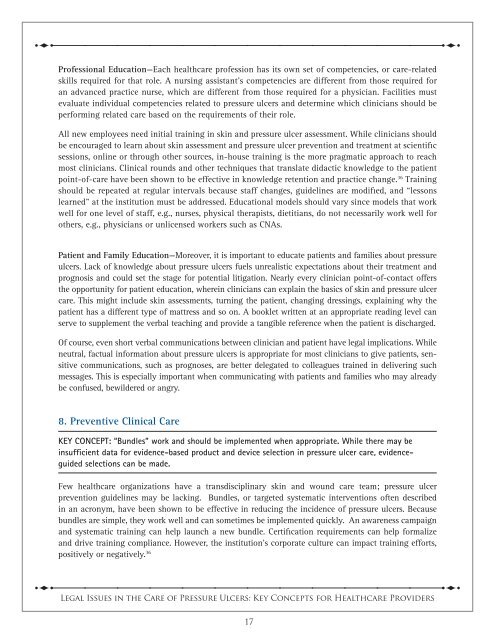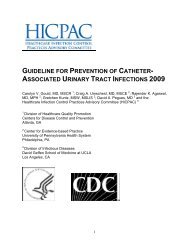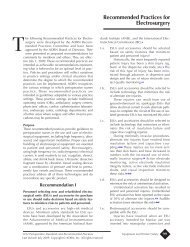Legal Issues in the Care of Pressure Ulcer Patients - Medline
Legal Issues in the Care of Pressure Ulcer Patients - Medline
Legal Issues in the Care of Pressure Ulcer Patients - Medline
Create successful ePaper yourself
Turn your PDF publications into a flip-book with our unique Google optimized e-Paper software.
sttttttttttttsPr<strong>of</strong>essional Education—Each healthcare pr<strong>of</strong>ession has its own set <strong>of</strong> competencies, or care-relatedskills required for that role. A nurs<strong>in</strong>g assistant’s competencies are different from those required foran advanced practice nurse, which are different from those required for a physician. Facilities mustevaluate <strong>in</strong>dividual competencies related to pressure ulcers and determ<strong>in</strong>e which cl<strong>in</strong>icians should beperform<strong>in</strong>g related care based on <strong>the</strong> requirements <strong>of</strong> <strong>the</strong>ir role.All new employees need <strong>in</strong>itial tra<strong>in</strong><strong>in</strong>g <strong>in</strong> sk<strong>in</strong> and pressure ulcer assessment. While cl<strong>in</strong>icians shouldbe encouraged to learn about sk<strong>in</strong> assessment and pressure ulcer prevention and treatment at scientificsessions, onl<strong>in</strong>e or through o<strong>the</strong>r sources, <strong>in</strong>-house tra<strong>in</strong><strong>in</strong>g is <strong>the</strong> more pragmatic approach to reachmost cl<strong>in</strong>icians. Cl<strong>in</strong>ical rounds and o<strong>the</strong>r techniques that translate didactic knowledge to <strong>the</strong> patientpo<strong>in</strong>t-<strong>of</strong>-care have been shown to be effective <strong>in</strong> knowledge retention and practice change. 36 Tra<strong>in</strong><strong>in</strong>gshould be repeated at regular <strong>in</strong>tervals because staff changes, guidel<strong>in</strong>es are modified, and “lessonslearned” at <strong>the</strong> <strong>in</strong>stitution must be addressed. Educational models should vary s<strong>in</strong>ce models that workwell for one level <strong>of</strong> staff, e.g., nurses, physical <strong>the</strong>rapists, dietitians, do not necessarily work well foro<strong>the</strong>rs, e.g., physicians or unlicensed workers such as CNAs.Patient and Family Education—Moreover, it is important to educate patients and families about pressureulcers. Lack <strong>of</strong> knowledge about pressure ulcers fuels unrealistic expectations about <strong>the</strong>ir treatment andprognosis and could set <strong>the</strong> stage for potential litigation. Nearly every cl<strong>in</strong>ician po<strong>in</strong>t-<strong>of</strong>-contact <strong>of</strong>fers<strong>the</strong> opportunity for patient education, where<strong>in</strong> cl<strong>in</strong>icians can expla<strong>in</strong> <strong>the</strong> basics <strong>of</strong> sk<strong>in</strong> and pressure ulcercare. This might <strong>in</strong>clude sk<strong>in</strong> assessments, turn<strong>in</strong>g <strong>the</strong> patient, chang<strong>in</strong>g dress<strong>in</strong>gs, expla<strong>in</strong><strong>in</strong>g why <strong>the</strong>patient has a different type <strong>of</strong> mattress and so on. A booklet written at an appropriate read<strong>in</strong>g level canserve to supplement <strong>the</strong> verbal teach<strong>in</strong>g and provide a tangible reference when <strong>the</strong> patient is discharged.Of course, even short verbal communications between cl<strong>in</strong>ician and patient have legal implications. Whileneutral, factual <strong>in</strong>formation about pressure ulcers is appropriate for most cl<strong>in</strong>icians to give patients, sensitivecommunications, such as prognoses, are better delegated to colleagues tra<strong>in</strong>ed <strong>in</strong> deliver<strong>in</strong>g suchmessages. This is especially important when communicat<strong>in</strong>g with patients and families who may alreadybe confused, bewildered or angry.8. Preventive Cl<strong>in</strong>ical <strong>Care</strong>Key Concept: “Bundles” work and should be implemented when appropriate. While <strong>the</strong>re may be<strong>in</strong>sufficient data for evidence-based product and device selection <strong>in</strong> pressure ulcer care, evidenceguidedselections can be made.Few healthcare organizations have a transdiscipl<strong>in</strong>ary sk<strong>in</strong> and wound care team; pressure ulcerprevention guidel<strong>in</strong>es may be lack<strong>in</strong>g. Bundles, or targeted systematic <strong>in</strong>terventions <strong>of</strong>ten described<strong>in</strong> an acronym, have been shown to be effective <strong>in</strong> reduc<strong>in</strong>g <strong>the</strong> <strong>in</strong>cidence <strong>of</strong> pressure ulcers. Becausebundles are simple, <strong>the</strong>y work well and can sometimes be implemented quickly. An awareness campaignand systematic tra<strong>in</strong><strong>in</strong>g can help launch a new bundle. Certification requirements can help formalizeand drive tra<strong>in</strong><strong>in</strong>g compliance. However, <strong>the</strong> <strong>in</strong>stitution’s corporate culture can impact tra<strong>in</strong><strong>in</strong>g efforts,positively or negatively. 36stttttttttttts<strong>Legal</strong> <strong>Issues</strong> <strong>in</strong> <strong>the</strong> <strong>Care</strong> <strong>of</strong> <strong>Pressure</strong> <strong>Ulcer</strong>s: Key Concepts for Healthcare Providers17
















